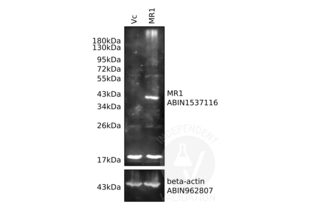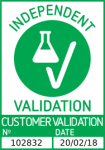beta Actin anticorps
-
- Antigène Voir toutes beta Actin (ACTB) Anticorps
- beta Actin (ACTB) (Actin, beta (ACTB))
-
Reactivité
- Humain, Souris, Poulet, Lapin, Porc, Boeuf (Vache), Hamster, Chévre, Poisson
-
Hôte
- Souris
-
Clonalité
- Monoclonal
-
Conjugué
- Cet anticorp beta Actin est non-conjugé
-
Application
- Western Blotting (WB), ELISA
- Specificité
- THETM beta Actin Antibody, mAb, Mouse reacts with mouse, rabbit, chicken, human, hamster, cow, goat, fish, and pig. It has not yet been tested in other species.
- Réactivité croisée (Details)
- Cross reactivity in other species has not yet been tested.
- Purification
- Protein G affinity column
- Immunogène
- A synthetic peptide DDDIAALVVDNGSG coupled - KLH
- Clone
- 2D1D10
- Isotype
- IgG
- Top Product
- Discover our top product ACTB Anticorps primaire
-
-
- Indications d'application
-
Working concentrations for specific applications should be determined by the investigator. The appropriate concentrations may be affected by secondary antibody affinity, antigen concentration, the sensitivity of the method of detection, temperature, the length of the incubations, and other factors. The suitability of this antibody for applications other than those listed below has not been determined. The following concentration ranges are recommended starting points for this product.
ELISA: 0.1-1.0 µg/mL
Western blot: 1.0 µg/mL
Other applications: user-optimized - Restrictions
- For Research Use only
-
- by
- Dr. Randy Brutkiewicz Laboratory, Department of Microbiology and Immunology, Indiana University School of Medicine
- No.
- #102832
- Date
- 20.02.2018
- Antigène
- ACTB
- Numéro du lot
- Application validée
- Western Blotting
- Contrôle positif
- lysates from HEK293 cells untransfected or transfected with human MR1 cDNA
- Contrôle négative
- Conclusion
Passed. ABIN962807 recognizes human beta actin in HEK293 cell lysates.
- Anticorps primaire
- ABIN962807
- Anticorps secondaire
- goat anti-rabbit Dye-IR800 conjugated antibody (Advansta, R-05060-250, lot 17083179)
- Full Protocol
- Grow HEK293 cells in DMEM medium (Lonza, 12-614F, lot 0000618582) supplemented with serum (Hyclone, SH30071.03, lot AAG205460) and antibiotics (Hyclone, SV30010, lot J150013), at 37°C and 5% CO2 dish to 70-90% confluency.
- Transfect cells with pCDNA 3.1 neo (-) (Invitrogen) containing human MR1 cDNA (Genecopoeia) using Polyethylenimine (Polysciences, 23966) following the manufacturer´s instructions.
- Lyse cells in cold lysis buffer (10mM Tris pH7.4, 150mM NaCl, 0.5mM EDTA, 2% CHAPS).
- Determine total protein content of the lysates using Commassie Protein Assay Reagent (Thermo Scientific, 1856209, lot NL179252).
- Denature 200µg total protein for 5min at 95°C in 20µl Laemmli SDS sample buffer and subsequently separate them on a SDS-PAGE gel using Acrylamide/Bis Premixed (Bio-Rad, 61-0125, lot 260000477) for 2-3h at 100V.
- Transfer proteins onto PVDF membrane (Millipore, IPVH00010, lot K5AA6843U) with a Western blotting system for ON at 4°C at 150mA.
- Block the membrane with blocking buffer (2% BSA/PBS/0.05%Tween-20) for 1h at RT.
- Incubate membrane with:
- loading control rabbit anti beta-actin (antibodies-online, ABIN962807) diluted 1:500 in blocking buffer ON at 4°C.
- primary rabbit anti-MR1 antibody (antibodies-online, ABIN1537116, lot SA111213CH) diluted 1:1000 in blocking buffer ON at 4°C.
- Wash membrane 3x for 10min with PBS/0.05%Tween-20.
- Incubate membrane with secondary goat anti-rabbit Dye-IR800 conjugated antibody (Advansta, R-05060-250, lot 17083179) diluted 1:10000 in PBS/0.05% Tween-20 for 1h at RT.
- Wash membrane 3x for 10min with PBS/0.05% Tween-20.
- Reveal protein bands using an Odyssey imaging system (LI-COR Biosciences).
- Notes
The beta Actin antibody ABIN962807 reveals a protein of the expected molecular weight of beta actin in lysates of human HEK293 cells.
Validation #102832 (Western Blotting)![Testé avec succès 'Independent Validation' signe]()
![Testé avec succès 'Independent Validation' signe]() Validation ImagesProtocole
Validation ImagesProtocole -
- Format
- Lyophilized
- Reconstitution
- Reconstitute the lyophilized antibody with deionized water to the final concentration of 0.5 mg/mL.
- Buffer
- PBS, pH 7.4, containing 0.02 % Sodium azide, without BSA
- Agent conservateur
- Sodium azide
- Précaution d'utilisation
- WARNING: Reagents contain sodium azide. Sodium azide is very toxic if ingested or inhaled. Avoid contact with skin, eyes, or clothing. Wear eye or face protection when handling. If skin or eye contact occurs, wash with copious amounts of water. If ingested or inhaled, contact a physician immediately. Sodium azide yields toxic hydrazoic acid under acidic conditions. Dilute azide-containing compounds in running water before discarding to avoid accumulation of potentially explosive deposits in lead or copper plumbing.
- Stock
- 4 °C/-20 °C
- Stockage commentaire
- The antibody is stable in lyophilized form if stored at -20°C or below. The reconstituted antibody can be stored for 2-3 weeks at 2-8°C. For long term storage, aliquot and store at -20°C or below. Avoid repeated freezing and thawing cycles.
-
-
: "NOTCH-induced aldehyde dehydrogenase 1A1 deacetylation promotes breast cancer stem cells." dans: The Journal of clinical investigation, (2014) (PubMed).
: "Flow cytometry assessment of the purity of human retinal pigment epithelial primary cell cultures." dans: Journal of immunological methods, Vol. 389, Issue 1-2, pp. 61-8, (2013) (PubMed).
-
: "NOTCH-induced aldehyde dehydrogenase 1A1 deacetylation promotes breast cancer stem cells." dans: The Journal of clinical investigation, (2014) (PubMed).
-
- Antigène
- beta Actin (ACTB) (Actin, beta (ACTB))
- Autre désignation
- beta Actin (ACTB Produits)
- Synonymes
- anticorps BRWS1, anticorps PS1TP5BP1, anticorps ACTA1, anticorps Actx, anticorps E430023M04Rik, anticorps beta-actin, anticorps ps1tp5bp1, anticorps act-2, anticorps actb, anticorps B-actin, anticorps LOC100174883, anticorps LOC100304816, anticorps A, anticorps ACT5C, anticorps Ac5C, anticorps Act, anticorps Act-5C, anticorps Act5, anticorps Act5c, anticorps Actin, anticorps Actin/BAP47, anticorps Actin5C, anticorps BAP47, anticorps Bap47, anticorps CG4027, anticorps Dmel\\CG4027, anticorps M32055, anticorps T11, anticorps act, anticorps act 5C, anticorps act5C, anticorps actin, anticorps actin5C, anticorps anon-EST:fe2D2, anticorps beta-actin/Bap47, anticorps cyt5C, anticorps l(1)G0009, anticorps l(1)G0010, anticorps l(1)G0025, anticorps l(1)G0079, anticorps l(1)G0117, anticorps l(1)G0177, anticorps l(1)G0245, anticorps l(1)G0330, anticorps l(1)G0420, anticorps l(1)G0486, anticorps Bact, anticorps ACT-5, anticorps ACTB, anticorps B-ACTZF, anticorps actba, anticorps bact, anticorps bactin1, anticorps bactzf, anticorps wu:fd18f05, anticorps A26C1B, anticorps POTE2alpha, anticorps POTEACTIN, anticorps Beta-actin, anticorps actin beta, anticorps actin, beta, anticorps cytoplasmic actin OlCA1, anticorps beta-actin, anticorps Actin 5C, anticorps actin gamma 1, anticorps actin, beta 1, anticorps actin, beta L homeolog, anticorps beta actin, anticorps POTE ankyrin domain family member F, anticorps actin, beta like 2, anticorps actin, cytoplasmic 1, anticorps ACTB, anticorps Actb, anticorps actb, anticorps LOC100174883, anticorps LOC100304816, anticorps Act5C, anticorps ACTG1, anticorps actb1, anticorps actb.L, anticorps LOC100136352, anticorps POTEF, anticorps ACTBL2, anticorps LOC109073280
- Sujet
- Beta-actin is one of the six different actin isoforms that have been identified. The actin molecules found in cells of various species and tissues tend to be very similar in their immunological and physical properties. As a consequence, it has been difficult to produce potent antisera against this protein. Therefore, the availability of monoclonal antibodies to beta-actin provides a useful and specific tool in the study of the intracellular distribution of beta-actin and the static and dynamic aspects of the cytoskeleton.
- Pathways
- Myometrial Relaxation and Contraction, Cell-Cell Junction Organization, Maintenance of Protein Location, Phototransduction
-


 (2 références)
(2 références) (1 validation)
(1 validation)



